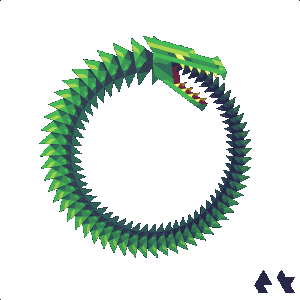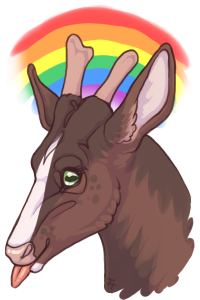skemma04 wrote:Just wondering;
Can we draw it on the computer, save it, and post it on here?
I could send you the link to the exact post it is on here (in a PM). I'd include what it eats etc. on the post.
Yes, PM entries are accepted :3
skemma04 wrote:Just wondering;
Can we draw it on the computer, save it, and post it on here?
I could send you the link to the exact post it is on here (in a PM). I'd include what it eats etc. on the post.
same ur two different years...what are the odds


Nyhlians
Crystallium cauda
Nyhlians are mammalian carnivores about as tall as a Labrador Retriever. They have a strange, gem-like protuberance on the end of their tail, the cause of which is unknown. Their body is covered in short coarse hair. Nyhlians have a very good sense of hearing and smell, and have powerful night vision. The average life span of a Nyhlian is 20 years in the wild.
Nyhlians have a long but skinny body. They have powerful leg muscles designed for leaping. The tail is quite dangerous as it can whip you with its powerful tail and cause bruising. The gem-like protuberance on the end of the tail is hard and slightly translucent. It is not shown to have any special powers or affect the Nyhlian in any way, but gives it its scientific name, which means 'Crystal tail'.
Nyhlians are carnivores and are known to consume most small mammals and birds. They are known to occasionally hunt fish. They sneak up and pounce on their prey, and deliver the killing blow with a sharp bite to the neck.
Nyhlians usually are covered in stripes or covered in patches resembling those of the clouded leopard. These patterns, although they look similar, almost never match the pattern of another Nyhlian. The coloring of a Nyhlian varies, from shades of gray to shades of brown to shades of orange. Very rarely a mutation in the fur color chromosone will occur, causing unnatural colors.
Nyhlians live in temparate deciduous and pine forests across North America. They will make their homes in a variety of places, from hollow trees to large bushes with the interior cleared out. They make small nests out of leaves or pine needles, and line the inside with whatever soft objects they can find.
Nyhlians are solitary animals that don't interact very often. When two Nyhlians meet, several things could happen: If both Nyhlians are male, they will probably fight each other. If both Nyhlians are female, they will probably ignore each other. And if they are both the opposite sex, the male will likely try to mate, unless the female already has cubs. Male Nyhlians each have large territories that no other male Nyhlian is allowed to trespass on. These territories range in size from 1 square mile to 100 square miles, depending on the terrain and population. Females are allowed to pass between territories without being attacked, mainly because each male Nyhlian wants to mate with them.
Once a female Nyhlian mates, she will search for a safe place to stay until her cubs can survive on their own. She picks out a spot near shallow water, and with plenty of prey and shelter. She will then begin to make a nest and wait for her cubs to come. The average gestation period is about 4 to 5 months, then give birth to 1 to 3 cubs. The mother will stay with the cubs and take care of them until they can survive in the wild, for around six months.

CinnamonHearts wrote:When does it end? I'll join, but I need to know how much time I have ^^

same ur two different years...what are the odds
Users browsing this forum: No registered users and 7 guests